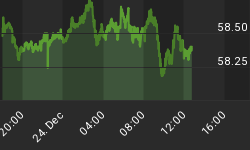If you look hard enough at the charts, you might be able to see the infamous Santa Claus pattern. It is a price pattern, similar to the cup and handle or maybe it is the head and shoulders, that looks like a rotund person with a white beard in a baggy, red suit. If you are having trouble seeing the Santa Claus pattern don't worry many investors are having trouble too. But keep looking because it is December and it is the "end of the month". And these things magically appear -- just like that when you least expect it. Yes, there seems to be a lot of hope riding on the rotund man in a sleigh, and that is about the best I can say about this market. I am not so sure hope is such a good strategy, but I guess hope is better than nothing. At least it is a strategy.
Outside of hope, I would not look to sentiment picture to see where the buyers are coming from. The "dumb money" is neutral, and the Rydex market timer is modestly bullish. There won't be short covering to add fuel to any rally. Company insiders are not committed either. Where are the buyers going to come from? Maybe Santa knows.
The "Dumb Money" indicator (see figure 1) looks for extremes in the data from 4 different groups of investors who historically have been wrong on the market: 1) Investors Intelligence; 2) MarketVane; 3) American Association of Individual Investors; and 4) the put call ratio. This indicator shows neutral sentiment.
Figure 1. "Dumb Money"/ weekly
Figure 2 is a weekly chart of the SP500 with the InsiderScore "entire market" value in the lower panel. From the InsiderScore weekly report: "A sell bias continued across the market as our Industry Score, our main indicator of prevailing sentiment, fell to its worst level in a year. This was the result of a build of negative sentiment that began at the end of October, was interrupted by a nice burst of buying/drop in selling in late November, and followed up by an increase in selling since the beginning of the current month. Week-over-week, there was a demonstrable drop in the number of sellers and overall the conviction displayed by sellers lessened. There was, however, a marked increase in the number of actionable sells, an interesting development considering the relatively high level of selling this quarter but not entirely surprising at the end of the calendar year, when insiders - like other so many other Americans - are trying to figure out tax strategies."
Figure 2. InsiderScore "Entire Market" value/ weekly
Figure 3 is a weekly chart of the SP500. The indicator in the lower panel measures all the assets in the Rydex bullish oriented equity funds divided by the sum of assets in the bullish oriented equity funds plus the assets in the bearish oriented equity funds. When the indicator is green, the value is low and there is fear in the market; this is where market bottoms are forged. When the indicator is red, there is complacency in the market. There are too many bulls and this is when market advances stall. Currently, the value of the indicator is 57.94%. Values less than 50% are associated with market bottoms. Values greater than 58% are associated with market tops.
Figure 3. Rydex Total Bull v. Total Bear/ weekly
Let me also remind readers that we are offering a 1 month FREE TRIAL to our Daily Sentiment Report (formerly Premium Content), which focuses on daily market sentiment and the Rydex asset data. This is excellent data based upon real assets not opinions! We have a new 1-click up process! Credit cards are not required.
TheTechnicalTake offers a FREE e-newsletter: HERE
















